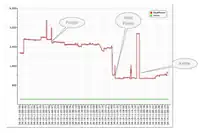Home energy monitor
A home energy monitor is a device that provides information about a personal electrical energy usage to a consumer of electricity. Devices may display the amount of electricity used, plus the cost of energy used and estimates of greenhouse gas emissions. The purpose of such devices is to assist in the management of power consumption. Several initiatives has been launched to increase the usage of home energy monitors. Studies have shown a reduction of home energy when the devices are used.


Description
A home energy monitor device provides information about electrical energy usage to a consumer of electricity (i.e., a homeowner). In addition to the amount of electrical usage, devices may display other information, including the cost of energy used and estimates of greenhouse gas emissions. The purpose of such devices is to assist in the management of power consumption.
Monitors consist of a measuring component and a display component. Electricity use is measured with an inductive clamp placed around the electric main, via the electric meter (either through an optical port, or by sensing the meters actions), by communicating with a smart meter, or by direct connection to the electrical system.
The display portion may be remote from the measurement, communicating with the sensor using a cable, network, power line communications, or using radio. Online displays are also available which allow the user to use an internet connected display to show near real-time consumption.
Initiatives
Australia
In January 2009 the government of the state of Queensland, Australia began offering wireless energy monitors as part of its ClimateSmart Home Service program. By August 2009, almost 100,000 homes had signed up for the service, by August 2010 that number had risen to 200,000 homes.[1][2] By the end of the program more than 335,000 households across Queensland had received the service with the Elite energy monitoring device supplied by Efergy Technologies.
In mid-2013 the government of the state of Victoria, Australia enabled Zigbee-based In-Home Displays to be connected to Victorian Smart Meter.[3] From September 2019, the Victorian households are eligible to avail rebates for home energy monitor installation under the Victorian Energy Upgrades Program.[4][5]
Google PowerMeter
Google PowerMeter was a software project of Google's philanthropic arm, Google.org, to help consumers track their home electricity usage.[6] It was launched on October 5, 2009 and ended on September 16, 2011.[7]
Studies
Various studies have shown a reduction in home energy use of 4-15% through use of home energy display.[8]
A study using the PowerCost Monitor deployed in 500 Ontario homes by Hydro One showed an average 6.5% drop in total electricity use when compared with a similarly sized control group. Hydro One subsequently offered free power monitors to 30,000 customers based on the success of the pilot.[9] According to World Economic Forum 2022, Google supports some companies around the world in different segments. Blue Line Innovations also indicates 100,000 units in the market today.
Another study carried out in the city of Sabadell (Spain) in 2009 using the Efergy e2 in 29 households during a six-month period came to 11.8% on a weekly comparison between the first and last weeks of the campaign. On a monthly basis, the savings were 14.3%. Expected annual CO2 savings for all households is estimated to be 4.1 tonnes; projected CO2 emissions savings for 2020 are 180.6 tonnes.[10]
See also
References
- Jones, Kate (August 11, 2009). "Nearly 100,000 Homes Sign up to Evict 'No One' and Save on Bills". Archived from the original on 2012-03-11. Retrieved 2011-03-20.
- Jones, Kate (August 4, 2010). "200,000 QLD Homes Get Climatesmart and Save Millions". Archived from the original on 2012-03-11. Retrieved 2011-03-20.
- http://www.switchon.vic.gov.au/how-can-i-take-charge-of-my-power-bill/energy-saver-incentive/in-home-%5B%5D
- "Inclusion of app-based in-home display units". Essential Services Commission. 2021-09-13. Archived from the original on 2021-10-05. Retrieved 2021-10-05.
- "In-home Display (IHD) Electricity Monitor (Free In Victoria)". Ecofin Solutions. 2021-05-04. Archived from the original on 2021-10-05. Retrieved 2021-10-05.
- Verne Kopytoff; Ryan Kim (2009-02-22). "Google plans meter to detail home energy use". San Francisco Chronicle. Retrieved 2009-02-11.
- "Google PowerMeter - Save Energy. Save Money. Make a Difference". Google.com. 2011-09-16. Archived from the original on September 2, 2011. Retrieved 2013-06-16.
- Jan Borstein, Karen Blackmore (March 2008). In-Home Display Units: An Evolving Market, Part 1 (Report).
- "Hydro One offers free electricity monitors to 30,000 customers" (PDF). January 2007. Archived from the original (PDF) on 2009-03-18. Retrieved 2009-02-12.
- "ManagEnergy - Supporting local and regional sustainable actions". Archived from the original on 2016-03-12. Retrieved 2011-10-25.